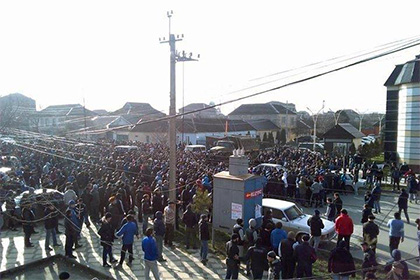
Khasavyurt Protest Shows Growing Power of Salafists in Dagestan
Publication: Eurasia Daily Monitor Volume: 13 Issue: 25
By:

Two months ago (December 2015), authorities in Dagestan attempted to shut down mosques in the capital Makhachkala that they did not control. The attempt ended in an embarrassing defeat for the authorities and the official mufti of the republic. The mufti lost the fight for the mosques, and the imams he appointed could not function and were forced to withdraw from those Muslim places of worship (see EDM, December 4, 2015).
It should have taught the mufti and the authorities a lesson, but it turns out it did not. On January 29, the authorities shut down the Salafist mosque in Shamkhal village, in the Makhachkala suburbs. The police descended on the mosque before Friday prayers and said that the mosque would resume operations only after Dagestan’s official mufti replaces the elected imam with his own candidate (Kavkazsky Uzel, January 29). Two days later, on January 31, the authorities shut down Khasavyurt’s “Severnaya” [“Northern”] mosque, one of the city’s two Salafist mosques, under the false pretext of mosque officials lacking certain documentation. When it turned out that the mosque’s documentation was intact, the authorities then claimed that rebel recruitment had taken place there. On December 26, the police detained the “Severnaya” imam on the pretext that he was in possession of a grenade launcher. While the imam was under investigation, the parishioners elected a new imam—Muhammad Nabi—without consulting the republican mufti. Earlier, on December 1, the mosque had riveted public attention after unidentified individuals killed its then-imam, Suleiman Kokreksky (Suleiman Suleimanov), near the Khasavyurt city hospital (Yuga.ru, February 1).
The closure of the mosque in Khasavyurt did not follow the pattern of what happened earlier in Shamkhal village. At a roundtable organized by the newspaper Chernovik, in Makhachkala, on February 2, it was revealed that the police in Khasavyurt had acted on Makhachkala’s orders when they attempted to shut down the mosque (Kasparov.ru, February 2). It is clear that such a decision could not have been made without a green light from officials in Makhachkala. The roundtable participants, Salafist imams from various parts of the Dagestani capital, concluded that fighting terrorism by shutting down mosques was a shortsighted policy (Kavpolit.com, February 2).
At the same time, members of the Council of Imams of Khasavyurt gave a press conference in Makhachkala, at which they stated that the authorities were forcing six imams of mosques in Khasavyurt to resign. Those mosques have 12,000–15,000 parishioners, most of them young people. “People are exasperated,” one of the imams said. “Everyone should understand that shutting down the so-called Wahhabi mosques is not only a Salafi problem” (Mk.ru, February 2). The crackdown on mosques is not limited to Dagestan: authorities across Russia have ordered the demolition of 15 mosques so far, including mosques in Tambov, Kaliningrad, Novy Urengoi, Ussuriysk, Kislovodsk and Pyatigorsk.
By closing the mosque earlier in the week, the authorities intended to prevent Friday prayers there. That, however, was a miscalculation: crowds of young and strongly motivated “Severnaya” mosque parishioners took to Khasavyurt’s streets along with their supporters to protest against the action (YouTube, February 1).
The authorities were probably surprised by such behavior. The protesters chanted “La ilaha illallah!” (“There is no deity but God” or “There is no God but Allah”) and “Allahu Akbar!” (“God is Great!”) and moved toward the administration of the city of Khasavyurt. Media reported that there were 5,000 participants, but videos indicate a somewhat higher number of protesters, which is unprecedented for Khasavyurt. The crowd did not scream or insult anyone; instead, they performed a collective Friday prayer on the square in front of the city administration. District police and the military were dispatched to the city, but no clashes ensued. Under the pressure of such a large rally, the city authorities returned the keys to the mosque to its imam (Chernovik.net, February 2).
It was not simply a protest action. The extraordinary events in Khasavyurt showed that the city has significantly changed since the start of the second Russian-Chechen war in 1999. In the past, the authorities asserted that Salafists comprise only a small minority in the republic, numbering several dozen people at most. The authorities in Khasavyurt see that their numbers are now hundreds of times greater than they estimated. The conflict in Khasavyurt undermined the government’s prestige and handed a victory to the mosque parishioners. The parishioners showed that victories over the authorities are possible if unity is achieved. Dagestan once again surprised observers, who can say that the situation in the republic is changing so quickly that in a few years, Sufis will no longer be in charge. As the religion of the majority in the North Caucasus, Sufism is losing ground to an alliance of Sufi sheikhs and the authorities. The public protests are therefore not so much Salafi protests as protests of people against government policies regarding Islam in general. The large crowds of protesters in Khasavyurt indicated that the social support base for the armed Islamic underground movement in the republic is much wider than many have thought.




